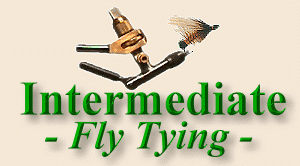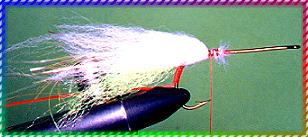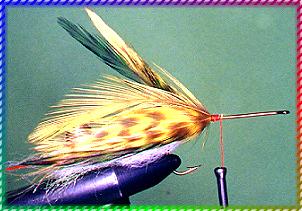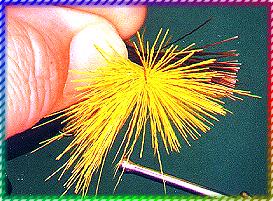I hope you practiced tying this week. I also hope you're not tired of
deer hair bugs yet. We have a long way to go before we totally finish
deer hair bass bugs. For the record, I'm having fun. I still enjoy
watching the deer hair flare and watching as the razor and scissors
reveal the product of creative hair work.
If you take a good look at frogs and many of the other critters living
in and around bass ponds, you'll notice that they aren't just one color.
They have several colors like white and green and yellow with spots and
blotches of brown and black and even other shades of green added in for a
type of camouflage. Actually, it's a combination of several colors that
create what we refer to as a frog.
That's what we're going to do this time. We're going to combine several
colors to create a distinctive shape and pattern common to many bass
flies. Actually, it's easy to create islands of color in hair heads if
you look at the fly from the inside out. Hmmm, maybe I need to explain
that one a little.
When you stack and shape deer hair, you need to try to see the finished
product as you apply the hair to the head. If islands of color are what
you're trying to create, you need to see those islands in your mind's eye
before you start adding hair to the hook. If you're trying to create a
black bordered island of yellow in a sea of green, you need to see that
island in your mind before you add any hair to the hook.
After you've gained the proper vision of the finished fly, all you need
to do is add hair in the order required to achieve that vision. If
you're trying to create an island of yellow bordered by black in a sea of
green, the first thing you add to the hook is the sea of green hair.
Next you add the border followed by the island of yellow. In other
words, add hair in the desired colors from the outside to the inside of
that island.
Remember that black spot of hair we created on the skirt of the first
diver we tied? We tied the first color of hair to the hook, then we
added another color (black) on top of that first color. That was called
stacking hair. Remember? If you add one more color of hair on top of
the second color, the second color becomes a border for the last color
added.
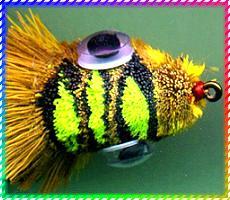
In this view of the head of a diving bug, you can see
islands of chartreuse hair bordered by black hair in a sea of golden
olive hair. First a small patch of golden olive hair is stacked on the
top of the hook by cinching the hair to the hook and letting it flare but
not spin. Next a patch of black hair is stacked on top of the golden
olive hair in the same manner. Finally, a patch of chartreuse hair is
stacked on top of the black and everything is compressed tightly with a
hair packer. When the hair is trimmed, you have an island of color
bordered by another color, in a sea of the first color tied to the
hook.
Sound complex? Hey, it isn't that hard. You'll be surprised by how
easy you can do this. I'm betting that once you've mastered this
technique, you'll have the confidence to tackle any tying technique I
throw at you.
Remember, we're trying to master techniques, not learn patterns. Once
you've mastered the technique, you can pick up any pattern book and use
that technique to tie any fly in the book that uses the technique. This
technique is used in Whitlock's hare water pup, his matuka sculpin and
about a dozen frog patterns.
Let's see how well you do with islands of color. Come on now, you can
do it.
|
